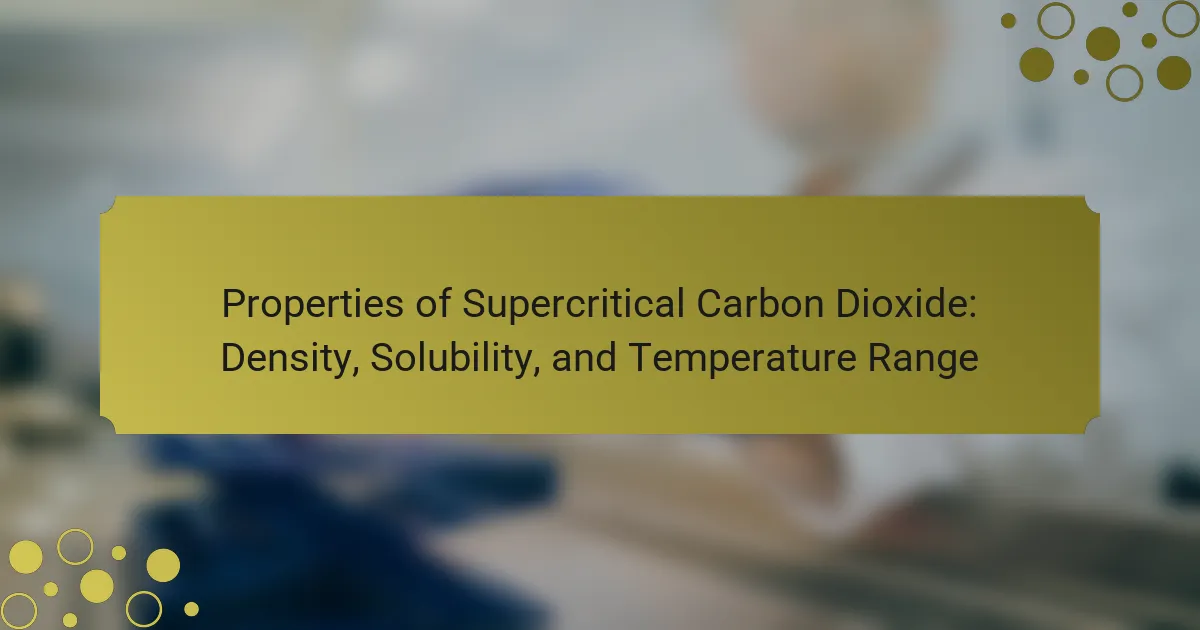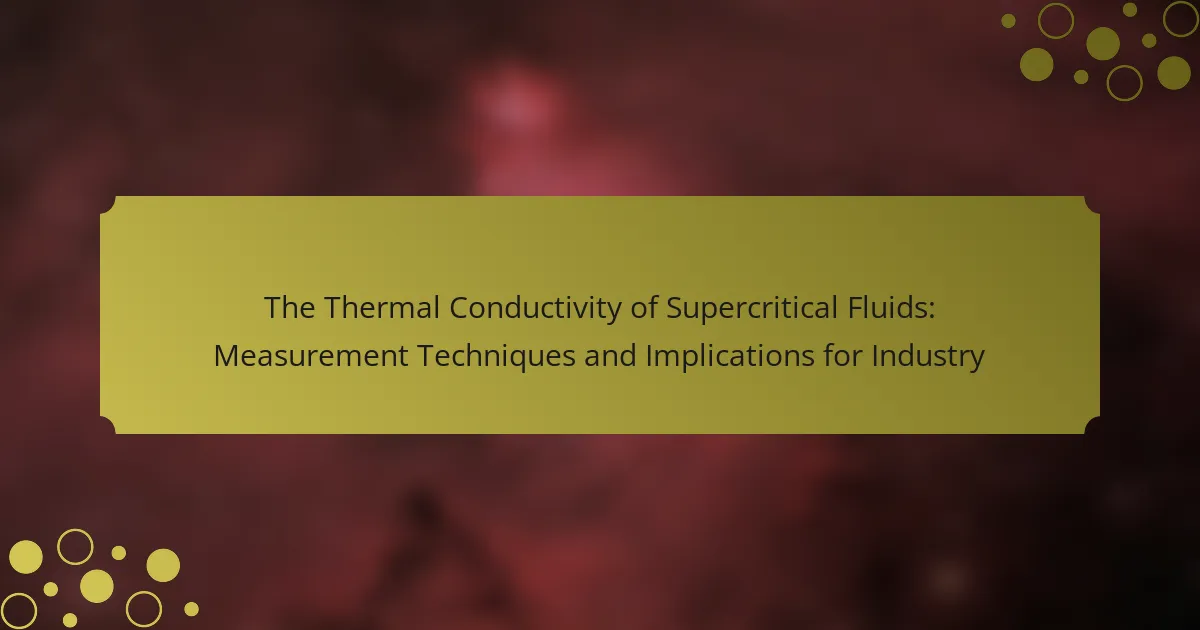Supercritical methanol and ethanol are solvents that exist above their critical temperature and pressure, exhibiting enhanced solvating capabilities. Supercritical methanol operates at a critical temperature of 239°C and a pressure of 8.1 MPa, while supercritical ethanol has a critical temperature of 240°C and a pressure of 6.1 MPa. These solvents are valuable in various industrial applications, including biodiesel production, organic synthesis, and pharmaceuticals, due to their ability to dissolve a wide range of organic compounds and facilitate faster reaction rates. Their environmentally friendly nature and effectiveness in extraction processes further highlight their significance in promoting greener practices across multiple sectors.
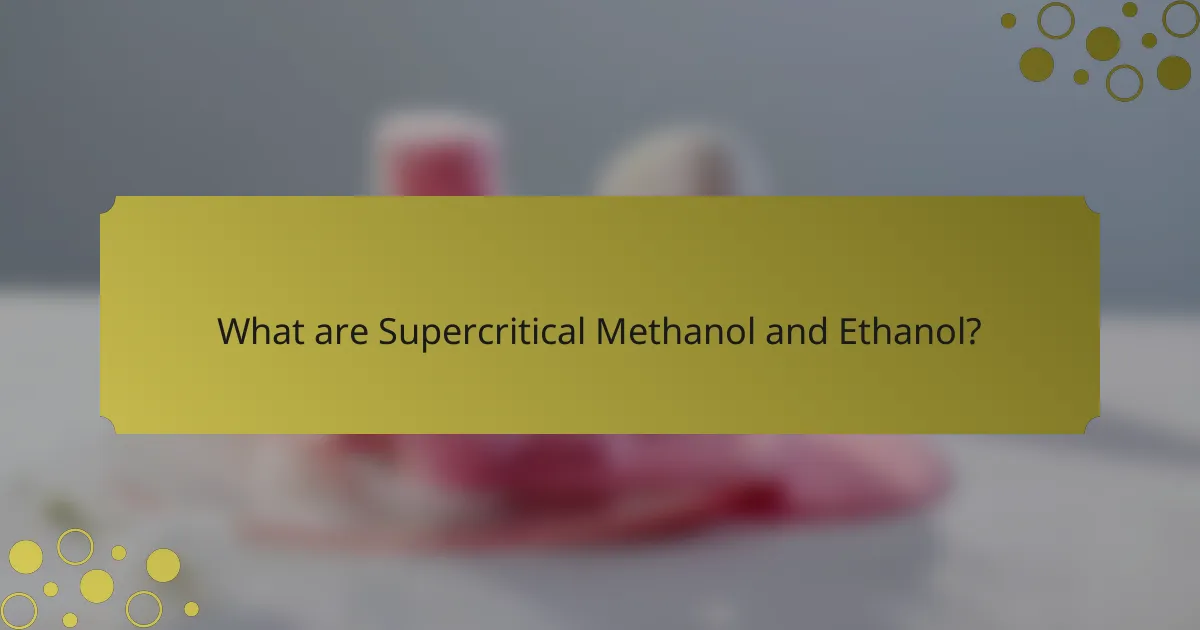
What are Supercritical Methanol and Ethanol?
Supercritical methanol and ethanol are solvents that exist above their critical temperature and pressure. In this state, they exhibit unique properties that enhance their solvating capabilities. Supercritical methanol operates at a critical temperature of 239°C and a pressure of 8.1 MPa. Supercritical ethanol has a critical temperature of 240°C and a pressure of 6.1 MPa. Both solvents can dissolve a wide range of organic compounds effectively. This makes them valuable in various industrial applications, including biodiesel production and organic synthesis. Their ability to facilitate reactions without the need for additional solvents is a significant advantage. Supercritical fluids are also environmentally friendly alternatives to traditional solvents.
How do Supercritical Methanol and Ethanol differ in composition?
Supercritical methanol and ethanol differ in their molecular composition. Methanol, with the chemical formula CH3OH, consists of one carbon atom, four hydrogen atoms, and one oxygen atom. Ethanol, on the other hand, has the chemical formula C2H5OH, containing two carbon atoms, six hydrogen atoms, and one oxygen atom. This difference in carbon and hydrogen content influences their properties. Methanol is typically more polar than ethanol, affecting its solvation capabilities. Additionally, the higher molecular weight of ethanol contributes to its different physical properties, such as boiling point and density.
What are the chemical structures of Supercritical Methanol and Ethanol?
Supercritical methanol has a chemical structure represented by the molecular formula CH3OH. In its supercritical state, methanol exhibits distinct properties, including reduced density and increased solvating power. Ethanol, on the other hand, has the chemical structure represented by the molecular formula C2H5OH. When ethanol reaches its supercritical state, it also shows unique characteristics, such as enhanced diffusivity and solubility. Both substances maintain their molecular structures but behave differently under supercritical conditions.
How do their physical properties compare?
Supercritical methanol and ethanol differ in several physical properties. Methanol has a lower boiling point of 64.7°C compared to ethanol’s 78.37°C. The density of supercritical methanol is approximately 0.2 g/cm³, while ethanol has a density of about 0.789 g/cm³. Methanol has a higher solubility in non-polar solvents, enhancing its effectiveness in certain industrial applications. In contrast, ethanol exhibits better miscibility with water due to its hydroxyl group. The viscosity of supercritical methanol is lower than that of ethanol, making it easier to pump in industrial processes. These differences in physical properties influence their respective applications in various industries, including biofuel production and chemical synthesis.
What is the significance of supercritical fluids in industrial applications?
Supercritical fluids are significant in industrial applications due to their unique properties. They exhibit both gas and liquid characteristics, allowing for enhanced solvation and mass transfer. This dual nature enables efficient extraction processes, such as in the food and pharmaceutical industries. Supercritical fluids can dissolve a wide range of substances, making them ideal for separating compounds. For instance, supercritical carbon dioxide is commonly used for decaffeinating coffee and extracting essential oils. Their low viscosity and high diffusivity improve reaction rates in chemical processes. Additionally, supercritical fluids are environmentally friendly alternatives to traditional solvents. They minimize hazardous waste and reduce the use of volatile organic compounds.
What are the defining characteristics of supercritical fluids?
Supercritical fluids are substances at a temperature and pressure above their critical point. In this state, they exhibit unique properties that differ from both gases and liquids. Supercritical fluids can diffuse through solids like a gas while dissolving materials like a liquid. Their density can be adjusted by changing pressure and temperature. This allows for tunable solubility, making them useful in various extraction processes. Supercritical fluids also have low viscosity, enhancing mass transfer rates. These characteristics enable efficient extraction and reaction processes in industrial applications. For example, supercritical carbon dioxide is commonly used in decaffeination and extraction of essential oils.
How does the supercritical state enhance solubility?
The supercritical state enhances solubility by combining properties of both gases and liquids. In this state, the substance exhibits increased density and reduced viscosity. This results in a higher solvent power, allowing more solute to dissolve. Supercritical fluids can penetrate porous materials more effectively than liquids. The unique density of supercritical fluids can be adjusted by changing temperature and pressure. This tunability makes them ideal for extracting compounds. For example, supercritical CO2 is widely used in extracting essential oils and flavors. Studies show that supercritical extraction yields higher purity and efficiency compared to traditional methods.
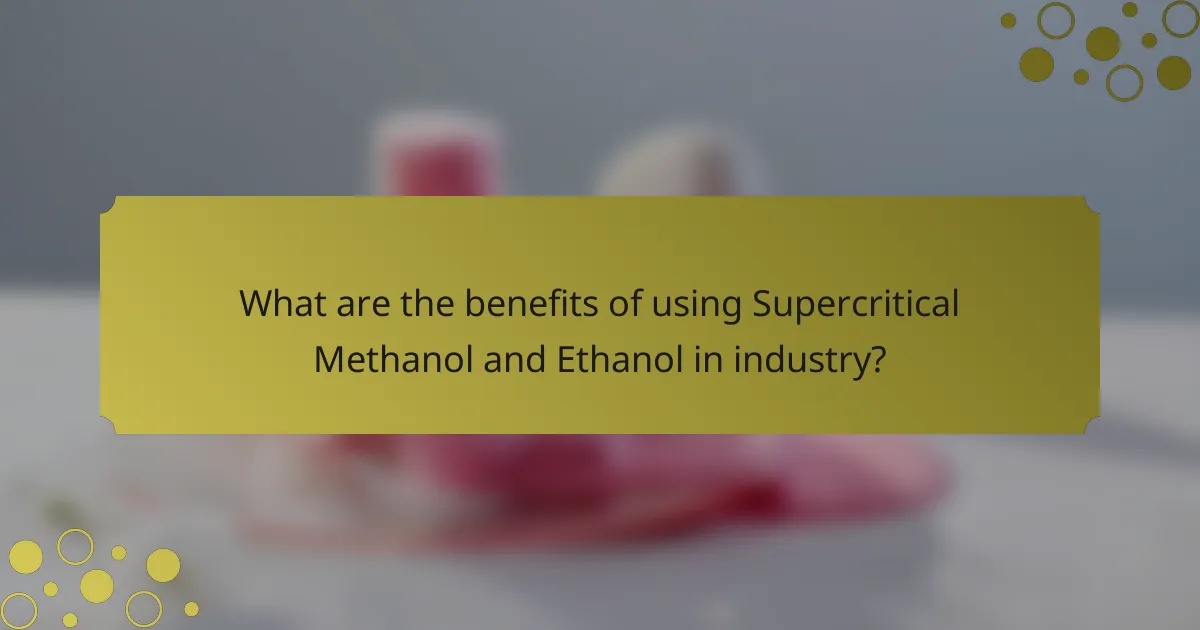
What are the benefits of using Supercritical Methanol and Ethanol in industry?
Supercritical methanol and ethanol offer several benefits in industrial applications. They serve as effective solvents for extraction processes. Their supercritical state enhances solubility for various compounds. This leads to higher extraction yields compared to traditional methods. Additionally, these solvents facilitate faster reaction rates in chemical processes. They reduce the need for harmful organic solvents, promoting greener practices. Supercritical methanol and ethanol also allow for easier separation of products after reactions. Their tunable properties enable customization for specific industrial needs.
How do these substances contribute to sustainable practices?
Supercritical methanol and ethanol contribute to sustainable practices by serving as renewable solvents and reactants in chemical processes. Both substances can be derived from biomass, reducing reliance on fossil fuels. Their use in biodiesel production exemplifies their sustainability, as they facilitate the transesterification of triglycerides into renewable fuel. This process generates fewer emissions compared to traditional fossil fuel methods. Additionally, supercritical methanol operates at lower temperatures and pressures, enhancing energy efficiency. Ethanol, as a biofuel, can reduce greenhouse gas emissions significantly, with studies showing up to a 40% reduction compared to gasoline. Together, these substances promote a circular economy by utilizing renewable resources and minimizing environmental impact.
What environmental benefits do Supercritical Methanol and Ethanol offer?
Supercritical Methanol and Ethanol provide significant environmental benefits. They contribute to reduced greenhouse gas emissions compared to conventional fuels. Their use promotes cleaner combustion processes, leading to lower particulate matter and nitrogen oxides. Supercritical fluids enhance the efficiency of biofuel production, minimizing waste and energy consumption. Ethanol from renewable sources decreases reliance on fossil fuels, supporting sustainability. Additionally, both substances can be produced from biomass, further reducing carbon footprints. These attributes make them favorable options in mitigating climate change impacts.
How do they compare in terms of energy efficiency?
Supercritical methanol is generally more energy-efficient than ethanol. Supercritical methanol can achieve higher reaction rates and lower energy input during processing. This results in reduced energy consumption in industrial applications. Studies indicate that supercritical methanol can convert biomass more efficiently than ethanol, achieving up to 90% energy recovery. Ethanol, while effective, often requires more energy for distillation and purification processes. The differences in energy efficiency are crucial for industries seeking sustainable solutions.
What are the economic advantages of using Supercritical Methanol and Ethanol?
Supercritical Methanol and Ethanol offer significant economic advantages in industrial applications. They enhance reaction rates, which reduces processing time and costs. Their ability to dissolve a wide range of compounds increases product yields. This leads to more efficient use of raw materials. The use of supercritical solvents minimizes waste generation, lowering disposal costs. Additionally, they allow for lower energy consumption compared to traditional methods. Studies indicate that these solvents can lead to a 30% reduction in energy costs in certain reactions. Overall, their efficiency and effectiveness contribute to lower operational expenses in various industries.
How do they impact production costs?
Supercritical methanol and ethanol impact production costs differently. Supercritical methanol often leads to lower production costs due to its higher efficiency in biomass conversion. It can process feedstocks faster than ethanol, reducing operational time and energy consumption.
Ethanol, while versatile, typically has higher feedstock and processing costs. The production of ethanol from corn, for instance, incurs significant agricultural and transportation expenses.
In contrast, supercritical methanol can utilize a broader range of feedstocks, including waste materials. This versatility can lower raw material costs and minimize waste disposal fees.
Research shows that supercritical methods can increase yield rates by up to 30% compared to traditional ethanol processes. This efficiency translates to reduced costs per unit of product.
Overall, the choice between supercritical methanol and ethanol can significantly influence production costs based on efficiency, feedstock options, and operational expenses.
What are the potential market opportunities for these substances?
Supercritical methanol and ethanol present significant market opportunities in various industries. Their unique properties allow for enhanced extraction processes in the food and pharmaceutical sectors. In biofuel production, supercritical methanol can improve efficiency and yield compared to traditional methods. Ethanol is widely used in beverages and as a solvent, maintaining a strong market presence. The growing demand for sustainable and renewable energy sources further boosts the market for both substances. Additionally, advancements in technology may lead to new applications, expanding their market potential.
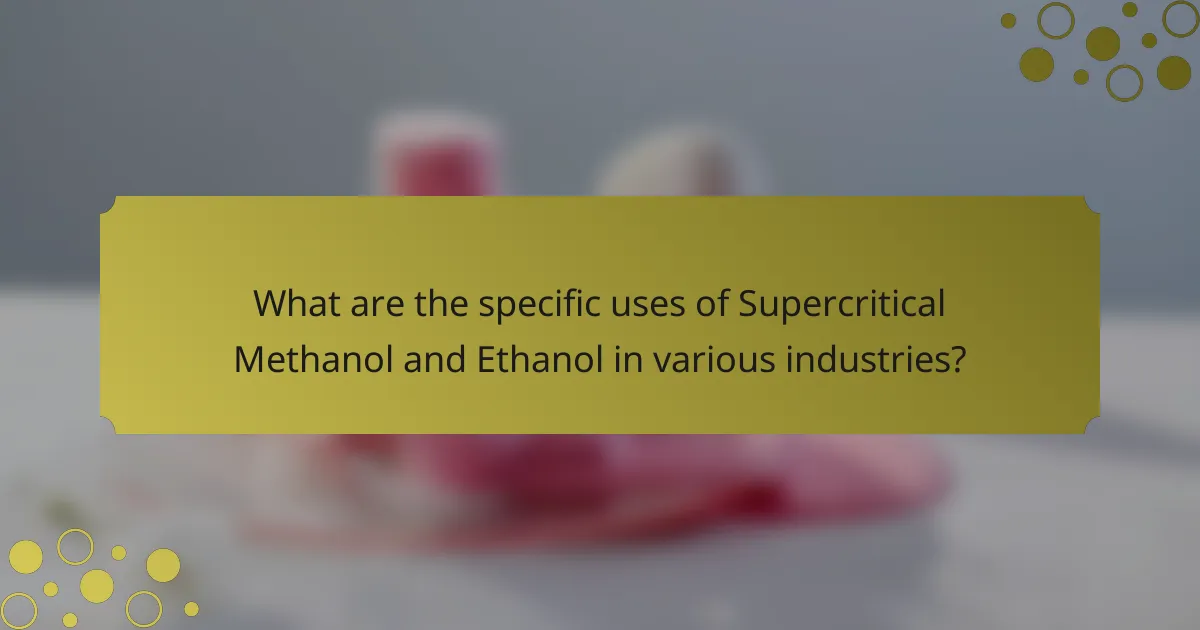
What are the specific uses of Supercritical Methanol and Ethanol in various industries?
Supercritical methanol and ethanol are utilized in various industries for their unique properties. In biodiesel production, supercritical methanol serves as a solvent for transesterification, enhancing yield and reaction rates. Supercritical ethanol is also used for transesterification, providing an alternative with lower toxicity. In pharmaceuticals, both solvents extract active compounds effectively, improving drug formulation. The food industry employs supercritical ethanol for extracting flavors and essential oils without harmful residues. Additionally, supercritical methanol is used in chemical synthesis, facilitating reactions under mild conditions. These applications demonstrate the versatility and efficiency of supercritical methanol and ethanol across multiple sectors.
How is Supercritical Methanol utilized in biodiesel production?
Supercritical methanol is utilized in biodiesel production through a process called transesterification. In this process, triglycerides from vegetable oils or animal fats react with supercritical methanol. The supercritical state enhances the reaction rate and yield of biodiesel. This method operates at high temperatures and pressures, typically around 300°C and 8-10 MPa. The advantages include a shorter reaction time and no need for catalysts. Studies have shown that supercritical methanol can produce biodiesel with high purity and conversion rates exceeding 90%. This efficiency makes it a promising alternative to traditional methods.
What processes involve Supercritical Methanol in biodiesel synthesis?
Supercritical methanol is involved in the transesterification process for biodiesel synthesis. This process occurs at high temperatures and pressures, where methanol becomes supercritical. In this state, methanol exhibits unique properties that enhance the reaction efficiency. It allows for the direct conversion of triglycerides into fatty acid methyl esters (biodiesel) without the need for catalysts.
Research shows that supercritical methanol can reduce reaction times significantly. Studies indicate that biodiesel yields can exceed 90% under optimal conditions. This process also enables the use of feedstocks with high free fatty acid content. Overall, supercritical methanol provides an effective method for biodiesel production.
What are the advantages of using Supercritical Methanol for this purpose?
Supercritical Methanol offers several advantages for industrial applications. It has a higher solvating power than traditional solvents. This enhances the extraction efficiency of valuable compounds. Additionally, Supercritical Methanol operates at lower temperatures. This reduces thermal degradation of sensitive materials. Its ability to dissolve both polar and non-polar substances is significant. This versatility enables a wide range of applications. Furthermore, the process is often more environmentally friendly. It generates fewer waste products compared to conventional methods. These advantages make Supercritical Methanol a preferred choice in various industries.
In what ways is Ethanol employed in pharmaceuticals and food industries?
Ethanol is employed in pharmaceuticals as a solvent, preservative, and disinfectant. In drug formulation, ethanol dissolves active ingredients effectively. Its antiseptic properties make it suitable for sanitizing medical equipment. Ethanol is also used in the production of tinctures and extracts.
In the food industry, ethanol serves as a flavoring agent and preservative. It helps in extracting flavors from herbs and spices. Ethanol is utilized in food processing for its antimicrobial properties. It also acts as a solvent in food additives. The FDA recognizes ethanol as generally safe for consumption in regulated amounts.
What roles does Ethanol play in extraction processes?
Ethanol serves as a solvent in extraction processes. It effectively dissolves various compounds, including polar and some non-polar substances. Ethanol’s ability to extract essential oils, flavors, and active ingredients makes it valuable in food and pharmaceutical industries. The solvent’s low toxicity enhances safety in extraction applications. Ethanol is also cost-effective compared to other solvents. Its volatility allows for easy removal after the extraction process. Additionally, ethanol’s effectiveness in cold extraction methods preserves sensitive compounds. These roles highlight ethanol’s significance in diverse extraction applications.
How does Ethanol ensure product safety and quality?
Ethanol ensures product safety and quality through its antimicrobial properties. It effectively kills bacteria and viruses, making it a common disinfectant. Ethanol concentrations of 60% to 90% are optimal for microbial inactivation. This concentration range is widely used in hand sanitizers and surface disinfectants. Ethanol also acts as a solvent, enhancing the solubility of various compounds. This property ensures uniformity and consistency in product formulations. Additionally, ethanol’s low toxicity compared to other solvents contributes to safer products. Its use in food and beverage industries is regulated for quality assurance. These factors collectively reinforce the safety and quality of products containing ethanol.
What are best practices for utilizing Supercritical Methanol and Ethanol in industrial applications?
Best practices for utilizing supercritical methanol and ethanol in industrial applications include optimizing temperature and pressure conditions. Maintaining temperatures between 200-300°C and pressures around 10-30 MPa is essential for effective extraction processes. Employing appropriate reactor designs enhances reaction efficiency and product yield. Continuous flow systems are preferred for scalability and consistency in production.
Utilizing catalysts can improve reaction rates and selectivity in chemical transformations. Regular monitoring of solvent purity ensures high-quality end products. Implementing safety protocols is crucial due to the flammable nature of these solvents. Finally, conducting thorough training for personnel on handling supercritical fluids promotes operational safety and efficiency.
Supercritical methanol and ethanol are solvents that exist above their critical temperature and pressure, exhibiting unique properties that enhance their solvating capabilities, making them valuable in various industrial applications. The article compares their molecular compositions, physical properties, and significance in industrial processes, highlighting their roles in biodiesel production, pharmaceuticals, and food industries. Additionally, it discusses the environmental and economic advantages of using these supercritical fluids, including their contributions to sustainability and energy efficiency. Key best practices for their application in industrial settings are also outlined, emphasizing the importance of optimizing conditions and ensuring safety.
